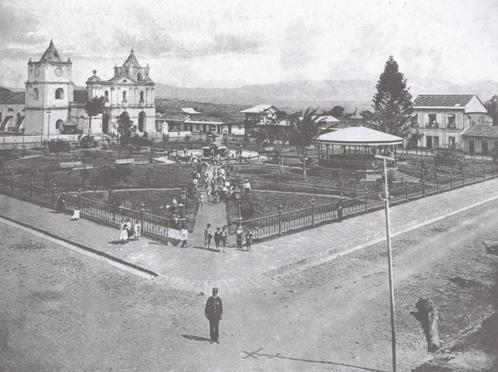The Battle of Ochomogo
 |
| Ochomogo Hill, Costa Rica |
Following New Spain’s defeat in the Mexican War of
Independence, a Mexican council and representatives
from the Kingdom of Guatemala (Guatemala, El Salvador, Honduras, Nicaragua, and
Costa Rica) declared independence from Spain. In the years that followed, the Costa Rican people
were fiercely divided with respect to the political direction of their country
and civil war ultimately broke out due to conflicting political visions. Those from Cartago and Heredia as well as
some Nicaraguans (imperialists collectively) tended to align with
self-appointed emperor Agustín I and the newly established Mexican empire. Those from San José and Alajuela (republicans)
sought to join the vision of “The Liberator” Simon Bolívar and join the Republic of Colombia or “Gran Colombia”.
 |
| Municipality of Heredia, Costa Rica |
More than fifty
years after the Spanish arrived in the “new world,” Cartago was pronounced the
capital of Costa Rica, which at the time was considered a colony of New Spain. While Cartago represented the highest
concentration of governmental influence during Spanish rule, the Spanish
government chose San
José as the location for a tobacco factory in 1784, granting San José monetary
influence through its lucrative industry during New Spain’s waning years. San Jose’s industrial infrastructure would
later play a key factor in Costa Rica’s decision to move its capital following
a stretch of political instability near the beginning of the 19th
century. After Spain’s direct, political
imposition was lifted in 1821 due to its defeat in the Mexican Civil War, the Costa
Rican government declared that the country would have “freedom from any power.” However, the manner in which government
officials exercised their political power next would prove that it was a hollow
statement fueled by the emotion of liberation from Spain. Just four days later, the government declared
that Costa Rica would become part of the Republic of Colombia. Outraged at the personal disadvantages of the
situation, the imperialists launched a coup d’etat with the goal of forcibly
aligning with Iturbide’s Mexico. Emboldened
to defend their national vision to
join Gran Colombia amidst political unrest, the republicans took up arms in
response to the imperialist coup.
| Father Miguel Hidalgo and his followers march towards Mexico city |
A week
following the official declaration of civil war, republican and imperialist
forces fought in the Battle of Arroyo near Alajuela. The few Republicans who remained, under the
leadership of mayor José Ángel Soto, fought to defend themselves from the
onslaught of a militia from Heredia. However,
without substantial numbers and only a single canon at their disposal, the
Alajuelans were overrun by the Heredian army and many of the houses in Alajuela
were destroyed and looted. With its new
inhabitants forcibly taking control, Alajuela became a temporary stronghold for
the imperialist cause.
Simultaneously,
sizeable forces from both armies converged at the hill of Ochomogo, located in
a valley sandwiched between the Irazú Volcano and the La Carpintera hills near
Cartago 75 miles to the southwest. The
republicans were lead by general Gregorio José Ramírez y Castro and field
general Antonio Pinto Soares while the imperialists were lead by Salvador Oreamuno,
Félix Oreamuno y Jiménez, and Joaquín de Oreamuno y Muñoz de la Trinidad. According to historian Ricardo Fernández
Guardia, Joaquín de Oreamuno y Muñoz de la Trinidad did not make an appearance
at the battle, but rather “stayed in bed relaxing for a few more hours” (Rafael
Obregón Loría "Hechos Militares y Políticos de Nuestra Historia
Patria", Museo Histórico
Cultural Juan Santamaría, Costa Rica,
1981). Despite apparent attempts to
negotiate a truce, shots rang out, sending both sides into violent
confrontation. The volcanic terrain
provided great cover for soldiers on each side to fire their muskets and
reload. When republican field general Antonio
Pinto Soares ordered the firing of his cannons, several imperialist leaders
left the battlefield with the realization that they were being overpowered. When the fighting ended, dozens of soldiers
lost their lives and hundreds sustained injuries. Due to the slow nature of international news
in those times, it took weeks for the imperialists to learn that the Mexican empire
fell two weeks after the Costa Rican civil war– essentially, their fight was in
vain. The country decided to join the
United Provinces of Central America.
| Donkey with Cannon |
It wasn’t
until the 1950s that a donkey’s actions in the decisive battle of Ochomogo were
examined and brought to the surface by a Cartago scholar named Fernando
Runebaum Leiva according to one source (although I am having trouble
finding more details about him and his research on the internet, including
scholarly databases). What exactly
transpired went un-publicized by both sides because the donkey’s actions were
regarded a military farce that diminished the patriotism of efforts in
battle. The story of the donkey comes in
with regard to the firing of the cannons.
According to one narrative, it was the imperialists who had the only cannons
because they hailed from the colonial capital Cartago, which harbored such
weapons left over from Spanish rule. Hauled
by donkeys, when the weapons were primed and pointed towards the republicans,
one of the donkeys suddenly turned, pointing the canon back at the imperialist
army! The cannon fired, causing immense
damage to its own soldiers and severely wounding the imperialist war effort in
the battle of Ochomogo. While the exact
details regarding what occurred are up for speculation, some believe that this
curious instance granted the battle and ultimately the civil war victory to the
republicans and contributed greatly to the decision to make San Jose the new
capital of Costa Rica.
| The National Theatre of Cost Rica, San José |

Comments
Post a Comment